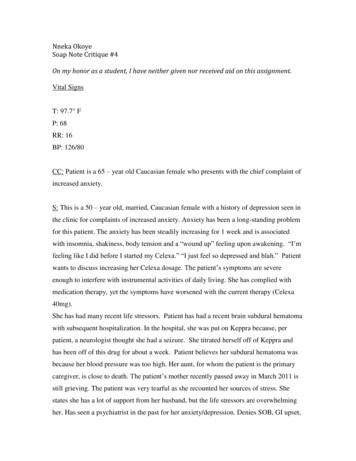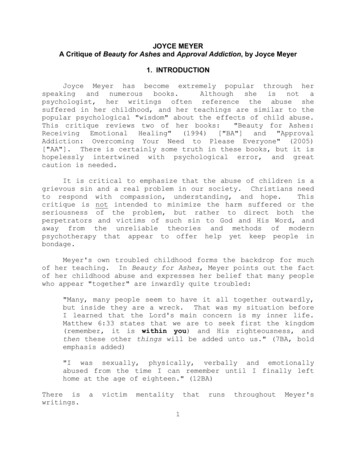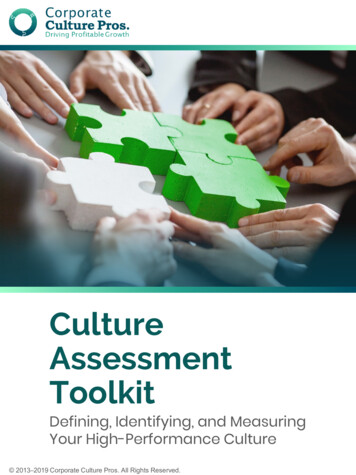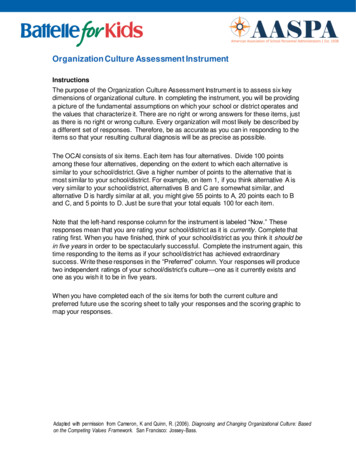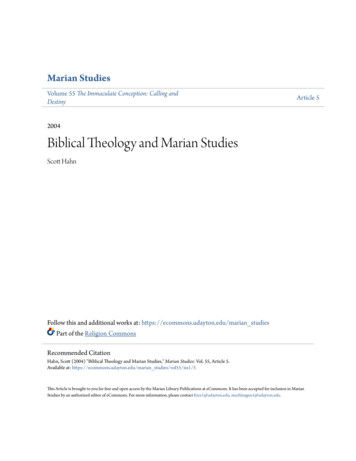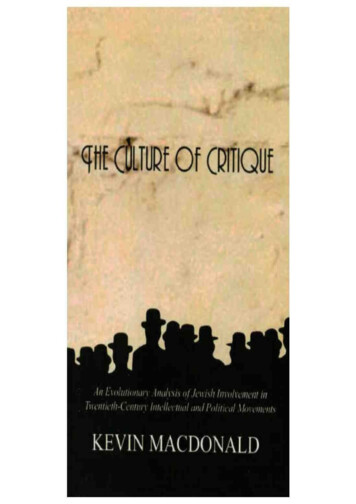
Transcription
The Culture of CritiqueAn Evolutionary Analysis ofJewish Involvement inTwentieth-Century Intellectual andPolitical MovementsKevin MacDonald2
Copyright 1998, 2002, 2013 Kevin MacDonald3
ContentsPreface to the Kindle Edition of 2013Preface to the Paperback Edition of 2002THE DECLINE OF ETHNIC CONSCIOUSNESS AMONG EUROPEAN-DERIVEDPEOPLE IN THE UNITED STATESTHE EVOLUTIONARY ORIGINS OF EUROPEAN INDIVIDUALISMTHE EVOLUTIONARY ORIGINS OF JEWISH COLLECTIVISM ANDETHNOCENTRISMJEWISH INVOLVEMENT IN COMMUNISM AND THE RADICAL LEFTFROM THE CULTURE OF CRITIQUE TO THE CULTURE OF THE HOLOCAUSTJEWS AND THE MEDIA: SHAPING “WAYS OF SEEING”JEWISH ORGANIZATIONS AND CENSORSHIP OF THE INTERNETTHE QUESTION OF BIASCONCLUSIONPreface to the Praeger Edition of 1998Chapter 1: Jews and the Radical Critique ofGentile Culture: Introduction and TheoryPRELIMINARY CONSIDERATIONSCONCEPTUALIZING THE JEWISH RADICAL CRITICISM OF GENTILE SOCIETYChapter 2: The Boasian School of Anthropologyand the Decline of Darwinism in the SocialSciencesTHE ETHNOPOLITICAL AGENDA OF CLAUDE LEVI-STRAUSSFRANZ BOAS AS INTELLECTUAL ETHNIC ACTIVISTBEYOND BOAS: RECENT EXAMPLES OF JEWISH POLITICAL AGENDASINFLUENCING SOCIAL SCIENCE RESEARCH: STEPHEN JAY GOULD, LEONKAMIN, R. C. LEWONTIN, JERRY HIRSCH, AND RICHARD LERNER4
CONCLUSIONAppendix to Chapter 2 of the Kindle Edition:Gould and Boas Committed Scientific FraudChapter 3: Jews and the LeftRADICALISM AND JEWISH IDENTIFICATIONSOCIAL IDENTITY PROCESSES, PERCEIVED JEWISH GROUP INTERESTS,AND JEWISH RADICALISMCONCLUSIONAppendix to Chapter 3 of the Kindle Edition: Stalin’sWilling Executioners: Jews as a Hostile Elite in theUSSRAPOLLONIANS AND MERCURIANSJEWISH SUPERIORITYWERE JEWISH RADICALS JEWS?BOLSHEVISM AS A JEWISH REVOLUTIONTHE THREE GREAT JEWISH MIGRATIONS OF THE TWENTIETH CENTURYTHE DECLINE OF THE JEWS IN THE SOVIET UNIONTHE ISSUE OF JEWISH CULPABILITYChapter 4: Jewish Involvement in thePsychoanalytic MovementCONQUERING ROME: FREUD’S JEWISH IDENTITYTHE SCIENTIFIC STATUS OF PSYCHOANALYSISPSYCHOANALYSIS AS A POLITICAL MOVEMENTPSYCHOANALYSIS AS A TOOL IN THE RADICAL CRITICISM OF WESTERNCULTURE: THE WIDER CULTURAL INFLUENCE OF FREUD’S THEORYCONCLUSIONChapter 5: The Frankfurt School of SocialResearch and the Pathologization of Gentile5
Group AllegiancesTHE POLITICAL AGENDA OF THE FRANKFURT SCHOOL OF SOCIALRESEARCHREVIEW OF THE AUTHORITARIAN PERSONALITYDISCUSSIONTHE INFLUENCE OF THE FRANKFURT SCHOOLJACQUES DERRIDA AS A JEWISH INTELLECTUAL ACTIVISTAppendix to Chapter 5 of the Kindle Edition:Neoconservatism as a Jewish MovementNON-JEWISH PARTICIPATION IN NEOCONSERVATISMUNIVERSITY AND MEDIA INVOLVEMENTINVOLVEMENT OF THE WIDER JEWISH COMMUNITYHISTORICAL ROOTS OF NEOCONSERVATISM: COMING TONEOCONSERVATISM FROM THE FAR LEFTNEOCONSERVATISM AS A CONTINUATION OF COLD WAR LIBERALISM’S“VITAL CENTER”THE FALL OF HENRY JACKSON AND THE RISE OF NEOCONSERVAT-ISM INTHE REPUBLICAN PARTYRESPONDING TO THE FALL OF THE SOVIET UNION6
NEOCONSERVATIVE PORTRAITSCONCLUSIONChapter 6: The Jewish Criticism of GentileCulture: A RepriseTHE GROUP COHESIVENESS OF JEWISH INTELLECTUAL MOVEMENTSTHE NEW YORK INTELLECTUALS AS A JEWISH MOVEMENTCHARISMATIC LEADERS AS CHARACTERISTIC OF JEWISH INTELLECTUALMOVEMENTSSUPPORT FROM THE WIDER JEWISH COMMUNITYACCESS TO ELITE UNIVERSITIES AND ELITE MEDIAMASQUERADING AS SCIENCE: JEWISH INTELLECTUAL MOVEMENTS ASRECREATING TRADITIONAL JEWISH RELIGIOUS IDEOLOGYAppendix to Chapter 6 of the Kindle Edition: Reviewof Eric P. Kaufmann’s The Rise and Fall of AngloAmerica19TH-CENTURY TRENDS: FREEDOM, REPRESENTATIVE GOVERNMENT,AND INDIVIDUALISM AS ANGLO-SAXON ETHNIC TRAITSFOUR AMERICAN LIBERAL INTELLECTUAL TRADITIONS FROM THE LATE19TH CENTURY TO THE PRESENT: LIBERTARIAN ANARCHISM, LIBERALPROTESTANTISM, ACADEMIC CULTURAL DETERMINISM, AND THESECULAR LEFTTHE PERIOD OF ETHNIC DEFENSE: 1880–1965THE RISE OF JEWISH INFLUENCECONCLUSION: THE FALL OF THE ANGLO-SAXONSChapter 7: Jewish Involvement in ShapingU.S. Immigration PolicyJEWISH INTELLECTUAL AND POLITICAL SUPPORT FOR CULTURALPLURALISMJEWISH ANTI-RESTRICTIONIST POLITICAL ACTIVITY UP TO 1924JEWISH ANTI-RESTRICTIONIST ACTIVITY, 1924–1945JEWISH ANTI-RESTRICTIONIST ACTIVITY, 1946–19527
JEWISH ANTI-RESTRICTIONIST ACTIVITY, 1953–1965Appendix: Jewish pro-immigration efforts in otherWestern countriesChapter 8: Conclusion: Whither Judaism andthe West?THE MULTICULTURAL DYSTOPIA: UNLEASHING GROUP-BASEDCOMPETITIONTHE GENETIC AND CULTURAL COSTS OF IMMIGRATION TO WHITESBibliography8
PREFACE TO THE KINDLE EDITION OF 2013This Kindle edition is a reprint of the 1998 edition along with several importantadditions, all of which are extensions of the ideas and themes of The Culture ofCritique.The Preface to the Paperback Edition of 2002 updates material covered inChapter 3, on Jewish involvement in the political and intellectual left. It alsoincludes topics that were in the background in the 1998 edition—sections onconceptualizing Europeans and Jews within an evolutionary framework, Jewishmedia influence, and the culture of the Holocaust.I have included a short appendix to Chapter 2 that includes recent findings thattwo of the central figures discissed in Chapter 2, Franz Boas and Stephen JayGould, committed scientific fraud motivated by advancing theirethnic/ideological agendas.The Appendix to Chapter 3 is an extensive review of Yuri Slezkine’s The JewishCentury that further updates the scholarship on Jewish involvement in theradical left.An essay titled “Neoconservatism as a Jewish Movement” is included as anappendix to Chapter 5. Neoconservatism is discussed briefly in several placesin the 1998 edition but the treatment was minimal because the movement hadrelatively little influence and did not command the allegiance of a substantialpercentage of American Jews. However, the sudden prominence ofneoconservatives in the George W. Bush administration, particularly in theaftermath of the the September 11, 2001 attacks, warranted a more detailedtreatment. This essay is intended as a chapter-length treatment of the topicalong the lines of the other intellectual movements discussed in The Culture ofCriqitue.The appendix to Chapter 6 expands material on the New York Intellectualscontained in Chapter 6. I had originally not intended to cover the New YorkIntellectuals in The Culture of Critique, but I included a fairly detailed discussionof them in Chapter 6 even though the main point of the chapter was toprovide a summary and review of the previously discussed Jewish intellectualmovements. The appendix is a review of Eric P. Kaufmann’s The Rise and Fallof Anglo-Americ which has a substantial section on the New York Intellectuals.9
It also touches on a number of important issues related to understanding theeclipse of White America, particularly the traits of Whites that becameweaknesses that were exploited by the nascent elite of Jewish intellectuals.10
PREFACE TO THE PAPERBACKEDITION OF 2002The Culture of Critique (hereafter, CofC) was originally published in 1998 byPraeger Publishers, an imprint of Greenwood Publishing Group, Inc. The thesis ofthe book is a difficult one indeed—difficult not only because it is difficult toestablish, but also because it challenges many fundamental assumptions aboutour contemporary intellectual and political existence.CofC describes how Jewish intellectuals initiated and advanced a number ofimportant intellectual and political movements during the 20th century. I arguethat these movements are attempts to alter Western societies in a manner thatwould neutralize or end anti-Semitism and enhance the prospects for Jewishgroup continuity either in an overt or in a semi-cryptic manner. Several of theseJewish movements (e.g., the shift in immigration policy favoring non-Europeanpeoples) have attempted to weaken the power of their perceived competitors—the European peoples who early in the 20th century had assumed a dominantposition not only in their traditional homelands in Europe, but also in the UnitedStates, Canada, and Australia. At a theoretical level, these movements are viewedas the outcome of conflicts of interest between Jews and non-Jews in theconstruction of culture and in various public policy issues. Ultimately, thesemovements are viewed as the expression of a group evolutionary strategy byJews in their competition for social, political and cultural dominance with nonJews.Here I attempt to answer some typical criticisms that have been leveledagainst CofC. (See also my website, www.kevinmacdonald.net.) I also discussissues raised by several books that have appeared since the publication of CofC.There have been complaints that I am viewing Judaism in a monolithic manner.This is definitely not the case. Rather, in each movement that I discuss, mymethodology has been:(1.) Find influential movements dominated by Jews, with no implication that allor most Jews are involved in these movements and no restrictions on what themovements are. For example, I touch on Jewish neo-conservatism which is adeparture in some ways from the other movements I discuss. In general,relatively few Jews were involved in most of these movements and significantnumbers of Jews may have been unaware of their existence. Even Jewish leftistradicalism—surely the most widespread and influential Jewish sub-culture of the20th century—may have been a minority movement within Jewish communitiesin the United States and other Western societies for most periods. As a result,11
when I criticize these movements I am not necessarily criticizing most Jews.Nevertheless, these movements were influential and they were Jewishlymotivated.(2.) Determine whether the Jewish participants in those movements identifiedas Jews AND thought of their involvement in the movement as advancing specificJewish interests. Involvement may be unconscious or involve self-deception, butfor the most part it was quite easy and straightforward to find evidence for thesepropositions. If I thought that self-deception was important (as in the case ofmany Jewish radicals), I provided evidence that in fact they did identify as Jewsand were deeply concerned about Jewish issues despite surface appearances tothe contrary. (See also Ch. 1 of CofC.)(3.) Try to gauge the influence of these movements on gentile society. Keep inmind that the influence of an intellectual or political movement dominated byJews is independent of the percentage of the Jewish community that is involvedin the movement or supports the movement.(4.) Try to show how non-Jews responded to these movements—for example,were they a source of anti-Semitism?Several of the movements I discuss have been very influential in the socialsciences. However, I do not argue that there are no Jews who do good socialscience, and in fact I provide a list of prominent Jewish social scientists who in myopinion do not meet the conditions outlined under (2) above (see Ch. 2 of CofC).If there was evidence that these social scientists identified as Jews and had aJewish agenda in doing social science (definitely not in the case of most of thoselisted, but possibly true in the case of Richard Herrnstein—see below), then theywould have been candidates for inclusion in the book. The people I cite ascontributing to evolutionary/biological perspectives are indeed ethnically Jewish,but for most of them I have no idea whether they either identity as Jews or ifthey have a Jewish agenda in pursuing their research simply because there is noevidence to be found in their work or elsewhere. If there is evidence that aprominent evolutionary biologist identifies as a Jew and views his work insociobiology or evolutionary psychology as advancing Jewish agendas, then he orshe should have been in CofC as an example of the phenomenon under studyrather than as simply a scientist working in the area of evolutionary studies.Interestingly, in the case of one of those I mention, Richard J. Herrnstein, AlanRyan (1994, 11) writes, “Herrnstein essentially wants the world in which cleverJewish kids or their equivalent make their way out of their humble backgroundsand end up running Goldman Sachs or the Harvard physics department.” This is astance that is typical, I suppose, of neo-conservatism, a Jewish movement Idiscuss in several places, and it is the sort of thing that, if true, would suggest thatHerrnstein did perceive the issues discussed in The Bell Curve as affecting Jewish12
interests in a way that Charles Murray, his co-author, did not. (Ryan contrastsMurray’s and Herrnstein’s world views: “Murray wants the Midwest in which hegrew up—a world in which the local mechanic didn’t care two cents whether hewas or wasn’t brighter than the local math teacher.”) Similarly, 20th-centurytheoretical physics does not qualify as a Jewish intellectual movement preciselybecause it was good science and there are no signs of ethnic involvement in itscreation: Jewish identification and pursuit of Jewish interests were not importantto the content of the theories or to the conduct of the intellectual movement.Yet Jews have been heavily overrepresented among the ranks of theoreticalphysicists.This conclusion remains true even though Einstein, the leading figure amongJewish physicists, was a strongly motivated Zionist (Fölsing 1997, 494–505),opposed assimilation as a contemptible form of “mimicry” (p. 490), preferred tomix with other Jews whom he referred to as his “tribal companions” (p. 489),embraced the uncritical support for the Bolshevik regime in Russia typical of somany Jews during the 1920s and 1930s, including persistent apology for theMoscow show trials in the 1930s (pp. 644–5), and switched from a high-mindedpacifism during World War I, when Jewish interests were not at stake, toadvocating the building of atomic bombs to defeat Hitler. From his teenage yearshe disliked the Germans and in later life criticized Jewish colleagues forconverting to Christianity and acting like Prussians. He especially dislikedPrussians, who were the elite ethnic group in Germany. Reviewing his life at age73, Einstein declared his ethnic affiliation in no uncertain terms: “My relationshipwith Jewry had become my strongest human tie once I achieved complete clarityabout our precarious position among the nations” (in Fölsing 1997, 488).According to Fölsing, Einstein had begun developing this clarity from an early age,but did not acknowledge it until much later, a form of self-deception: “As a youngman with bourgeois-liberal views and a belief in enlightenment, he had refused toacknowledge [his Jewish identity]” (in Fölsing 1997, 488).In other words, the issues of the ethnic identification and even ethnic activismon the part of people like Einstein are entirely separate from the issue of whethersuch people viewed the content of the theories themselves as furthering ethnicinterests, and, in the case of Einstein, there is no evidence that he did so. Thesame cannot be said for Freud, the New York Intellectuals, the Boasians, and theFrankfurt School, in which “scientific” theories were fashioned and deployed toadvance ethnic group interests. This ideological purpose becomes clear when theunscientific nature of these movements is understood. Much of the discussion inCofC documented the intellectual dishonesty, the lack of empirical rigor, theobvious political and ethnic motivation, the expulsion of dissenters, the collusionamong co-ethnics to dominate intellectual discourse, and the general lack ofscientific spirit that pervaded them. In my view, the scientific weakness of these13
movements is evidence of their group-strategic function.CofC was not reviewed widely. Indeed, only three reviews have appeared inmainstream publications, including a brief review by Kevin Hannan (2000) inNationalities Papers. Hannan’s review mostly describes the book, but hesummarizes his impressions by noting, “[MacDonald’s] iconoclastic evaluation ofpsychoanalysis, Marxism, multiculturalism, and certain schools of thought in thesocial sciences will not generate great enthusiasm for his work in academe, yetthis book is well written and has much to offer the reader interested in ethnicityand ethnic conflict.”The other reviews have raised several important issues that bear discussion.Frank Salter’s (2000) review in Human Ethology Bulletin discussed some of thecontroversy surrounding my work, particularly an acrimonious session at the 2000conference of the Human Behavior and Evolution Society where I was accused ofanti-Semitism by several participants. For me the only issue is whether I havebeen honest in my treatment of sources and whether my conclusions meet theusual standards of scholarly research in the social sciences. Salter notes that Ibased my research on mainstream sources and that the assertions that haveinfuriated some colleaguesare not only true but truisms to those acquainted with the diverseliteratures involved. Apart from the political sensitivity of the subject,much of the problem facing MacDonald is that his knowledge is often toofar ahead of his detractors to allow easy communication; there are notenough shared premises for constructive dialog. Unfortunately theknowledge gap is closing slowly because some of his most hostile critics,including colleagues who make serious ad hominem accusations, have notbothered to read MacDonald’s books.Salter also notes that those, such as John Tooby and Steven Pinker, who havedenigrated my competence as a researcher in the media, have failed to provideanything approaching a scholarly critique or refutation of my work. Sadly, thiscontinues. While there have been a number of ringing denunciations of my workin public forums, there have been no serious scholarly reviews by these critics,although they have not retracted their scathing denunciations of my work.Paul Gottfried (2000) raised several interesting issues in his review inChronicles, the paleo-conservative intellectual journal. (I replied to Gottfried’sreview and Gottfried penned a rejoinder; see Chronicles, September, 2000, pp. 4–5). Gottfried questions my views on the role of Jewish organizations andintellectuals with strong Jewish identifications as agents of change in the culturaltransformations that have occurred in Western societies over the last 50 years. Ingeneral, my position is that Jewish intellectual and political movements were anecessary condition for these changes, not a sufficient condition, as Gottfried14
supposes. In the case of the reversal in U.S. immigration policy, there simply wereno other pressure groups that were pushing for liberalized, multi-racialimmigration during the period under consideration (up to the enactment of thewatershed immigration bill of 1965). Nor were there any other groups orintellectual movements besides the ones mentioned in CofC that were developingimages of the U.S. as a multi-cultural, multi-ethnic society rather than a Europeancivilization. Gottfried attributes the sea change in immigration to “a generalcultural change that beset Western societies and was pushed by the managerialstate.” I agree that multi-ethnic immigration resulted from a general culturalshift, but we still must develop theories for the origin of this shift.A revealing development regarding Jewish attitudes toward immigration is anarticle by Stephen Steinlight (2001), former Director of National Affairs (domesticpolicy) at the American Jewish Committee (AJCommittee) and presently a SeniorFellow with the AJCommittee. Steinlight recommends altering “the traditionalpolicy line [of the organized Jewish community] affirming generous—really,unlimited—immigration and open borders,” even though for “many decent,progressive Jewish folk merely asking such fundamental questions is tantamountto heresy, and meddling with them is to conjure the devil.”Steinlight believes that present immigration policy no longer serves Jewishinterests because the new immigrants are less likely to be sympathetic to Israeland because they are more likely to view Jews as the wealthiest and mostpowerful group in the U.S.—and thus a potential enemy—rather than as victimsof the Holocaust. He is particularly worried about the consequences of Islamicfundamentalism among Muslim immigrants, especially for Israel, and hecondemns the “savage hatred for America and American values” among thefundamentalists. Steinlight is implicitly agreeing with an important thesis of mytrilogy on Judaism: Throughout history Jews have tended to prosper inindividualistic European societies and have suffered in non-Western societies,most notably in Muslim cultures where there are strong ingroup-outgroupsensibilities (e.g., MacDonald 1998a/2004, Ch. 2; the only exceptions to thisgeneralization have been when Jews have constituted an intermediary groupbetween an alien elite and oppressed native populations in Muslimsocieties.) Steinlight’s fears of the effects of a Balkanized America on Judaism areindeed well-grounded.Steinlight is exclusively concerned with Jewish interests—an example of Jewishmoral particularism which is a general feature of Jewish culture (see below).Indeed, his animosity toward the restrictionism of 1924–1965 shines throughclearly. This “pause” in immigration is perceived as a moral catastrophe. Hedescribes it as “evil, xenophobic, anti-Semitic,” “vilely discriminatory,” a “vastmoral failure,” a “monstrous policy.” Jewish interests are his only consideration,while the vast majority of pre-1965 Americans are described as a “thoughtless15
mob” because they advocate a complete moratorium on immigration.It seems fair to state that there is a communal Jewish memory about theperiod of immigration restriction as the high point of American anti-Jewishattitudes. Non-Jews have a difficult time fathoming Jewish communal memory.For strongly identified Jews, the “vilely discriminatory” actions of immigrationrestrictionists are part of the lachrymose history of the Jewish people.Immigration restriction from 1924–1965 is in the same category as the Romandestruction of the Temple in 70 A.D., the marauding Crusaders of the Middle Ages,the horrors of the Inquisition, the evil of the Russian Czar, and the rationallyincomprehensible calamity of Nazism. These events are not just images drawnfrom the dustbin of history. They are deeply felt images and potent motivators ofcontemporary behavior. As Michael Walzer (1994, 4) noted, “I was taught Jewishhistory as a long tale of exile and persecution—Holocaust history readbackwards.” From this perspective, the immigration restriction of 1924–1965 isan important part of the Holocaust because it prevented the emigration of Jewswho ultimately died in the Holocaust—a point that Steinlight dwells on at length.And as Walter Benjamin (1968, 262) notes, “Hatred and [the] spirit of sacrifice . . are nourished by the image of enslaved ancestors rather than that of liberatedgrandchildren.” This is important because whatever one’s attitudes about thecosts and benefits of immigration, a principal motivation for encouraging massivenon-European immigration on the part of the organized Jewish community hasinvolved a deeply felt animosity toward the people and culture responsible forthe immigration restriction of 1924–1965. (As indicated in Ch. 7, anothermotivation has been to lessen the power of the European-derived majority of theU.S. in order to prevent the development of an ethnically homogenous antiJewish movement.) This deeply held animosity exists despite the fact that theliberated grandchildren have been extraordinarily prosperous in the countrywhose recent past is the focus of such venom. The welfare of the United Statesand certainly the welfare of European-Americans have not been a relevantconsideration for Jewish attitudes on immigration. Indeed, as indicated inChapter 7, it’s easy to find statements of Jewish activists deploring the very ideathat immigration should serve the interests of the United States. And that is whythe organized Jewish community did not settle for a token victory by merelyeliminating the ethnically based quotas that resulted in an ethnic status quo inwhich Europeans retained their ethnic and cultural predominance. As indicated inChapter 7, immediately after the passage of the 1965 law, activists strovemightily to increase dramatically the numbers of non-European immigrants, apattern that continues to the present.And, finally, that is why support for open immigration spans the Jewish politicalspectrum, from the far left to the neo-conservative right. Scott McConnell,former editorial page editor and columnist for the New York Post, commented on16
the intense commitment to open immigration among Jewish neo-conservatives(see also Ch. 7):[1]Read some of Norman Podhoretz’s writing, particularly his recent book—the only polemics against anyone right of center are directed againstimmigration restrictionists. Several years ago I was at a party talking toNorman, and Abe Rosenthal came over, and Norman introduced us withthe words “Scott is very solid on all the issues, except immigration.” Thevery first words out of his mouth. This was when we were ostensibly onvery good terms, and I held a job which required important people to talkto me. There is a complicated history between the neo-cons and NationalReview [NR], which John O’Sullivan could tell better than I, but it involvedneo-con attacks on NR using language that equated modern dayimmigration restrictionism with the effort to send Jews back to Nazideath camps, a tone so vicious that [it] was really strange amongostensible Reaganite allies in 1995. . . . The Forward, a neo-connish Jewishweekly, used to run articles trying to link FAIR, an immigration restrictiongroup headed by former [Colorado governor] Richard Lamm, with neonazism, using . . . crude smear techniques . . . . None of my neo-confriends (at a time when all my friends were Jewish neo-cons) thoughtthere was anything wrong with this. . . . Read the Weekly Standard, readBen Wattenberg. Read the [Podhoretzes]. Or don’t. But if you wereengaged on the issue, you couldn’t help but being struck by this,particularly because it came as such a shock. One doesn’t like to namenames, because no one on the right wants to get on the bad side of theneo-cons, but I can think of one young scholar, who writes verytemperately on immigration-related issues and who trained under aleading neo-con academic. He told me he was just amazed at the neocons’ attachment to high immigration—it seemed to go against everyprinciple of valuing balance and order in a society, and being aware ofsocial vulnerabilities, that they seemed to advocate. Perhaps it’s worthsome time, writing a lengthy article on all this, on how the American rightlost its way after the Cold War. [Emphasis in text]THE DECLINE OF ETHNIC CONSCIOUSNESS AMONG EUROPEAN-DERIVEDPEOPLE IN THE UNITED STATESFundamental to the transformation of the United States as a result of massivenon-European immigration was the decline of ethnic consciousness amongEuropean peoples. It is fascinating to contrast the immigration debates of the1920s with those of the 1950s and 1960s. The restrictionists of the 1920sunabashedly asserted the right of European-derived peoples to the land they hadconquered and settled. There were many assertions of ethnic interest—that the17
people who colonized and created the political and economic culture of thecountry had a right to maintain it as their possession. This sort of morally selfassured nativism (even the word itself now has a pathological ring to it) can beseen in the statement of Representative William N. Vaile of Colorado, aprominent restrictionist, quoted in Chapter 7 of CofC.By the 1940s and certainly by the 1960s it was impossible to make suchassertions without being deemed not only a racist but an intellectualNeanderthal. Indeed, Bendersky (2000) shows that such rhetoric was increasinglyimpossible in the 1930s. One can see the shift in the career of racial theoristLothrop Stoddard, author of books such as The Rising Tide of Color Against WhiteWorld Supremacy and numerous articles for the popular media, such as Collier’s,Forum, and The Saturday Evening Post. Stoddard viewed Jews as highly intelligentand as racially different from Europeans. He also believed that Jews were criticalto the success of Bolshevism. However, he stopped referring to Jews completelyin his lectures to the Army War College in the late 1930s. The Boasian revolutionin anthropology had triumphed, and theorists who believed that race wasimportant for explaining human behavior became fringe figures. Stoddard himselfwent from being a popular and influential writer to being viewed as a security riskas the Roosevelt administration prepared the country for war with NationalSocialist Germany.Another marker of the change in attitude toward Jews was the response toCharles Lindbergh’s remarks in Des Moines, Iowa on the eve of U.S. entry intoWorld War II. Lindbergh’s advocacy of non-intervention was shaped not only byhis horror at the destructiveness of modern warfare—what he viewed as thesuicide of European culture, but also by his belief that a second European warwould be suicidal for the White race. In an article published in the popular mediain 1939 shortly after the outbreak of World War II, he stated that it was a war“among a dominant people for power, blind, insatiable, suicidal. Western nationsare again at war, a war likely to be more prostrating than any in the past, a war inwhich the White race is bound to lose, and the others bound to gain, a war whichmay easily lead our civilization through more Dark Ages if it survives at all”(Lindbergh 1939, 65).In order to maintain their dominance over other races, Lindbergh believed thatwhites should join together to fend off the teeming legions of non-whites whowere the real long-term threat. Lindbergh was not a Nordicist. He took a longterm view that Russia would be a white bulwark against the Chinese in the East.He advocated a racial alli
neoconservatism as a continuation of cold war liberalism’s “vital center” the fall of henry jackson and the rise of neoconservat-ism in the repu





